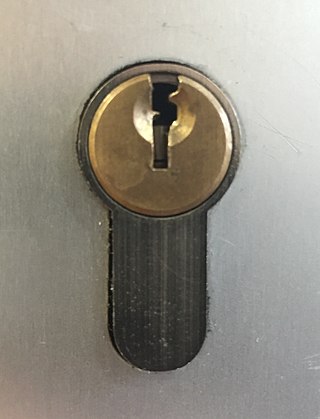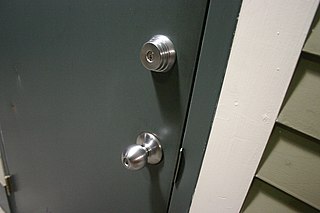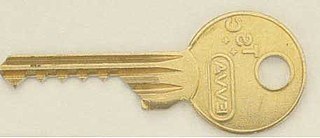
A knife is a tool or weapon with a cutting edge or blade, usually attached to a handle or hilt. One of the earliest tools used by humanity, knives appeared at least 2.5 million years ago, as evidenced by the Oldowan tools. Originally made of wood, bone, and stone, over the centuries, in step with improvements in both metallurgy and manufacturing, knife blades have been made from copper, bronze, iron, steel, ceramic, and titanium. Most modern knives have either fixed or folding blades; blade patterns and styles vary by maker and country of origin.

Lock picking is the practice of unlocking a lock by manipulating the components of the lock device without the original key.

A zipper, zip, fly, or zip fastener, formerly known as a clasp locker, is a commonly used device for binding together two edges of fabric or other flexible material. Used in clothing, luggage and other bags, camping gear, and many other items, zippers come in a wide range of sizes, shapes, and colors. In 1892, Whitcomb L. Judson, an American inventor from Chicago, patented the original design from which the modern device evolved.

The pin tumbler lock, also known as the Yale lock after the inventor of the modern version, is a lock mechanism that uses pins of varying lengths to prevent the lock from opening without the correct key.

A disc tumbler or disc detainer lock is a lock composed of slotted rotating detainer discs. The lock was invented by Finnish founder of Abloy, Emil Henriksson (1886–1959) in 1907 and first manufactured under the Abloy brand in 1918.

A lock is a mechanical or electronic fastening device that is released by a physical object, by supplying secret information, by a combination thereof, or it may only be able to be opened from one side, such as a door chain.

A deadbolt or deadlock is a type of lock morticed into a wooden door. Then, using a key from either side of the door, a bolt is thrown into the door frame, thus securing the door. It is distinct from a spring bolt lock because a deadbolt can only be opened by a key or handle. The more common spring bolt lock uses a spring to hold the bolt in place, allowing retraction by applying force to the bolt itself. A deadbolt can therefore make a door more resistant to entry without the correct key, as well as make the door more resistant to forced entry. A deadbolt is often used to complement a spring-bolt lock on an entry door to a building.

Padlocks are portable locks usually with a shackle that may be passed through an opening to prevent use, theft, vandalism or harm.
Medeco, a subsidiary of the Swedish Assa Abloy Group, is a lock manufacturer located in Roanoke County, Virginia, United States.

The Steyr M is a series of semi-automatic pistols developed by Steyr Mannlicher GmbH & Co KG of Austria for police services and the civilian shooting market. Design work on the new pistol began in the early 1990s and the final product known as the M9 was officially unveiled in the spring of 1999. The M40 version chambered in .40 S&W was developed before the M9, followed later by the M357 and two smaller variants of the M9 and M40 designated the S9 and S40 respectively. These pistols were developed primarily for concealed carry and have a shortened barrel, slide, smaller frame and a reduced magazine capacity. In 2013, the Steyr M (Medium) and S (Small) form factors were complemented by the L (Large) sized series and the C (Compact) sized series both available in 9×19mm Parabellum and .40 S&W chamberings as the L9-A1, L40-A1, C9-A1 and C40-A1.
Rekeying a lock is replacing the old lock pins with new lock pins.

A bayonet mount or bayonet connector is a fastening mechanism consisting of a cylindrical male side with one or more radial pins, and a female receptor with matching L-shaped slot(s) and with spring(s) to keep the two parts locked together. The slots are shaped like a capital letter L with serif ; the pin slides into the vertical arm of the L, rotates across the horizontal arm, then is pushed slightly upwards into the short vertical "serif" by the spring; the connector is no longer free to rotate unless pushed down against the spring until the pin is out of the "serif".

The GP100 is a family/line of double action five-, six-, seven-, or ten-shot revolvers made by Sturm, Ruger & Co., manufactured in the United States. Since its introduction, it has been produced with a number of variations including various barrel lengths and profiles, fixed or adjustable sights, and in blued carbon steel or stainless steel.

Lock bumping is a lock picking technique for opening a pin tumbler lock using a specially crafted bump key, rapping key or 999 key. A bump key must correspond to the target lock in order to function correctly.

A wafer tumbler lock is a type of lock that uses a set of flat wafers to prevent the lock from opening unless the correct key is inserted. This type of lock is similar to the pin tumbler lock and works on a similar principle. However, unlike the pin tumbler lock, where each pin consists of two or more pieces, each wafer in the lock is a single piece. The wafer tumbler lock is often incorrectly referred to as a disc tumbler lock, which uses an entirely different mechanism.
Schlage is an American lock manufacturer founded in 1920 by Walter Schlage. Schlage was headquartered in San Francisco from its inception until it relocated to Colorado Springs, Colorado, in 1997. Schlage also produces high-security key and cylinder lines Primus, Everest, and Everest Primus XP. Schlage is one of the most popular brands of consumer and commercial locks in the United States.

A snap gun, also known as lock pick gun, pick gun, or electric lock pick, is a tool that can be used to open a mechanical pin tumbler lock without using the key. A thin steel blade, similar in shape to a lock pick, is inserted into the lock and the snap gun briefly fires the blade against all of the lock pins simultaneously, momentarily freeing the cylinder and enabling it to be turned using a tension wrench. The snap gun is an alternative to a conventional lockpick, which requires other techniques such as raking to free the pins.
The term protector lock has referred to two unrelated lock designs, one invented in the 1850s by Alfred Hobbs, the other in 1874 by Theodor Kromer.

A magnetic keyed lock or magnetic-coded lock is a locking mechanism whereby the key utilizes magnets as part of the locking and unlocking mechanism. Magnetic-coded locks encompass knob locks, cylinder locks, lever locks, and deadbolt locks as well as applications in other security devices.
This is a glossary of locksmithing terms.















